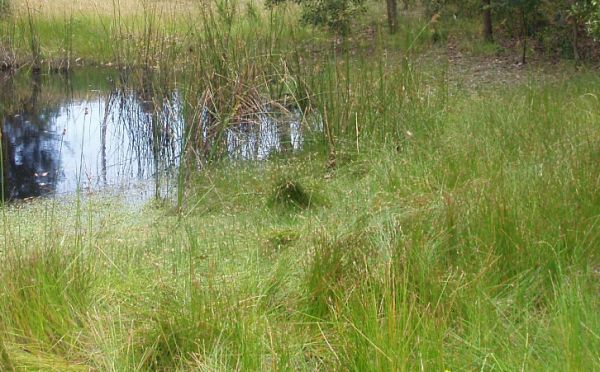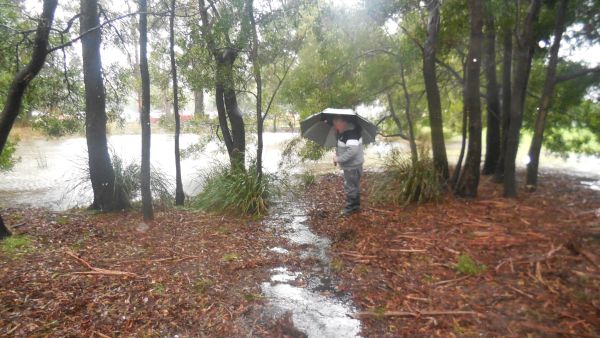
This spring-fed dam is situated on our 3 acre property in Mt Direction, Tasmania.

Spring-fed dam
It’s not a large dam by any stretch of the imagination, but here you could be forgiven for thinking it was just a little pond!
When we first saw it, as we were surveying the property and considering its purchase, it was so overgrown that it was very hard to tell where the grass ended and the dam began. I didn’t wan’t to sink into the dam unawares!
I can remember picking my way through the long grass, being really conscious of the potential of snakes.
Fed by a Seepage Spring so never runs dry
As our dam is ‘spring-fed’ it means it never runs dry. It can become very low, but there is always water in it, even when there has been no rain for months.
You can see the area where the spring water enters the dam. It seeps through the soil, rather than flowing in like a creek.
You may have wondered how a natural spring forms…
There are three different types of springs:
- Seepage spring
- Artesian spring
- Tubular spring
Our spring would be a ‘seepage spring’. This means it’s an area where groundwater, or water from underground from an aquifer, slowly seeps onto the surface.
Our property is on the very bottom slope of Mt Direction. The spring flows from the direction of the mountain, but all underground. It comes from the paddocks on the other side of the road, flows under the corner of our house and in a direct line to where the dam is situated.
The slope of our property is so mild that it’s almost flat… but not quite. The dam is situated on flat ground. All the land on the other side of the road, looking up towards Mt Direction, is on a much more definite slope until it rises into the mountain itself.
Dam just about at its lowest point
As the water platform falls during the summer, the dam water falls. This is about as low as I’ve ever seen the dam become:

It’s still more than enough water to keep our ducks happy. When it’s like this I usually refer to it as a puddle!
It was Christmas Day, and the dam was so low, but the day old ducklings were totally delighted with such a lovely new-born surprise!
It’s always constantly either rising or falling, according to the water plane underneath.
But then the rains come…
I remember the first time we ever saw the dam after some really wild weather we’d been having. It was amazing!

There was some major flooding in the district and the howling wind was tossing the bark off the trees all over the ground.
I really believed the dam was at it’s fullest capacity, but hey, there was more to come!
Dam overflow developed
There was an area used as an overflow, but I got the idea of making more of it. I dug it out, with the help of a neighbour and his back-hoe. Then we found a little bridge to put over it. It was lovely.

I dug it so it had three stages. First of all the dam had to rise to a very high level before the water would begin to flood into the overflow. There was then a level that took the water under the bridge and up a certain way before the level of the ground rose again.
I did this so that the dam could full to its maximum capacity, and only when super full would the water continue to escape and flow off down to the creek.

Rocky enjoys a cool off in all the lovely water, while the ducks are in seventh heaven!

The wild weather continued and our tanks were furiously overflowing. The water levels continued to rise with all this water from above, coming up and lapping at the feet of a group of blackwood trees.
A little stream was created from tank overflow. My husband surveys the happenings as our dam turns into a lake!

This is the result of it at the very highest level I’ve ever seen. Leaves had piled up against the fence and were preventing the water from flowing out as quickly. It didn’t matter too much, so we left it to gradually seep away at its own rate.
Dam becomes a little lake

So much water can end up in our dam that it fills up like a lake. The surrounding blackwood trees have to live for a few weeks with their roots totally submerged. It doesn’t appear to hurt them.
It’s at this time of the year, during the winter months, that we say we live lakeside! It’s fun!
Reflections

When the dam is nice and full it makes for some wonderful photography. Look at the sky reflected in the dam. Just brilliant!
In Tasmania, we experience the four seasons to their fullest extent. As it turns out, winter is the wet season, summer is the dry season. This is opposite to what they experience in the tropical zone, where monsoons bring all their wet.
I come from Gosford, New South Wales originally, and up there they get an average of over 1200 mm per year. Here in this part of Tasmania, often considered to be the wet and cold state, our rainfall average is only around 680 mm per year.
Eye-popped ducks!
I remember once when I was letting out the ducks. It was when the dam was virtually at it’s lowest. I remember that I had been thinking that it was going to take an awful lot of rain to fill the dam again. I wasn’t looking forward to the prospect!
Then overnight, the rains came… and came it did! It pelted down and by next morning the dam was full and beginning to flood.
Anyway, I let the ducks out and off they waddled off in great anticipation of a good swim in their puddle. They got to where they could see the dam and then they all stopped. Blinking their eyes they couldn’t believe what they were seeing! I could just imagine them thinking that it wasn’t like this last night… wow!
They were so happy to have so much water!
An icy surprise!
During the five years we have been on this property, there is only one morning that we found the dam had iced over. It was so funny!
My son went down to let out the birds, and as usual, the ducks half flew, half waddled straight for the dam.

On this particular occasion, the leading birds were in the air and flopped down into the dam. They hit the ice and my son said he watched as a couple of them did a 360, around and around, skimming out over the dam on top of it, and breaking up the ice. This shows the area where they landed…
It’s plain to see where they landed, and I can imagine they hurried out of there as quickly as they could. To the left of the ducks you can see a little round area clear of ice. This is where I found them swimming… all in this tiny spot.
It was about midday before the ice finally melted.

Some winters we get quite a few frosts, but only once has it been so bad that the water froze up.
![]()







Beautiful. Just beautiful.
Thank you for sharing.
Happy ducks to you!
Thank you Amber!